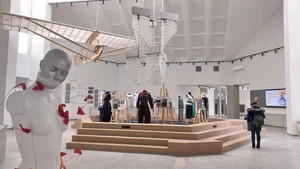In general, the term ‘sustainable fashion’ sounds impressive, but in some respects, fashion is always unsustainable. Manufacturing technology can be changed, such as changing the type of seam stitching, or using pure fibre fabrics instead of blends. Such small details are still underemphasised by designers. Many designers aim for the buzzword ‘sustainability’ without actually applying sustainable practices.
Take grape seed leather, for example. Yes, organic waste is used in the production process, which is great. However, current technological processes do not allow the material to be fully biodegradable, and the eco-friendly residue is mixed with polyester to stabilise the fibre. Thus, the 100 per cent sustainability is lost.
How can we move towards more environmentally friendly solutions in the fashion industry?
As part of the Green Deal, the EU has incorporated a European textile strategy into its Circular Economy Action Plan. This aims to reduce the environmental impact of fast fashion and encourage more sustainable textile production and consumption. However, the biggest issue, in my view, is that consumers are not yet ready for this transition, even though it has already been regulated for suppliers and manufacturers.
There needs to be more focus on consumer education at the EU level to explain the reasoning behind sustainable choices. Once consumers demand it, the market will reorganise itself. Currently, the production side is subject to one-sided requirements, but consumers still prioritise affordability. Therefore, even with good intentions, designers cannot always offer competitive products.
I feel there’s a lack of engaging presentations from manufacturers that truly educate consumers. Experience-based design could be a great way to show people the story behind a product and connect them more deeply with the creative process. Of course, achieving conscious consumption goals also requires changes in academia and the development of relevant competencies in the new generation of design students. A broader perspective could be incorporated into master’s programmes. This would enable people with different backgrounds to collaborate and apply their skills to the fashion market.
In your practice, you promote zero-waste production and create unique garments from fabric offcuts. How are such initiatives perceived outside of specialised competitions? Is circular design accessible to the average consumer?
Currently, this kind of creativity is a niche field. In my work, traditional, modern-classic products still account for the majority of sales. Nevertheless, we invest heavily in sustainability education by organising events and helping clients discover sustainable fashion.
It’s important to understand that, within the university, we sometimes become insular – among researchers and scientists who are deeply interested in innovations, sustainable fashion and its nuances are well understood. But the general public is still far from that. Buyers are looking for affordability, quality and aesthetic appeal. While I do meet clients who prioritise sustainability, for many, it’s still unfamiliar territory or only a secondary consideration.
So, while competitions won’t spark an immediate revolution in the fashion industry, they certainly help to educate consumers and introduce them to alternatives to fast fashion.
What mistakes do young fashion designers most often make when trying to apply sustainability principles to their work?
I wouldn’t call them mistakes – the intention to create in a cleaner, more responsible way should be celebrated. Moreover, small Lithuanian creators are highly dependent on market prices and geopolitical conditions, so they often have to compromise just to survive.
Individual designers tend to emphasise quality and durability in their work, which is not a mistake, but what’s lacking is a broader view of the whole system. Durability is not the only aspect of sustainability.
Young designers should be reminded that the fashion industry comprises a chain of processes, not just the final garment. This includes material selection, distribution processes, sewing technologies, quality control, logistics, recycling and disposal. There are numerous areas where circular principles can be applied. Only a systemic approach can truly ensure the integration of sustainability into design.
It seems that students are only partially familiar with issues of circularity. What changes do you think are needed in design studies to better prepare students to work with sustainable solutions?
It is essential to develop the ability to see the bigger picture. The biggest obstacle is getting stuck in old ways of thinking and being unable to create conceptual connections between elements that were not previously linked. The perfect conditions for this kind of education probably don’t yet exist – they must be discovered. Lithuania’s design sector lacks people with a broad perspective who can connect elements into systems that generate added value. We lack visionaries with diverse knowledge.
Fortunately, however, we are already seeing inspiring examples among KTU students. In the Fashion Engineering programme, for instance, projects range from studies on the use of wool waste to phygital collections – real garments enhanced with augmented reality solutions. Students are interested in engineering innovations, such as studying the properties of recycled materials and applying the latest digital technologies. There are countless unexplored topics in circular fashion and many sustainable innovations that have yet to be tested from a technical perspective – all we need are curious creators who care about building a cleaner future.
A new master’s programme, Design for Sustainable Future, is launching at Kaunas University of Technology.
This programme is designed for those wishing to develop innovative and sustainable design solutions. During their studies, students will learn to develop environmentally friendly materials, apply circular economy principles and use advanced digital design technologies. They will also learn to develop socially responsible projects. They will develop practical skills by working with real industry partners using participatory design methods and creative strategies. The programme was developed in collaboration with two leading design partners: Politecnico di Milano (Italy) and the strategic design agency The Critical (Lithuania).



